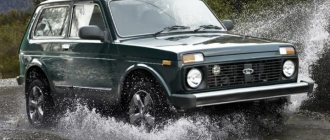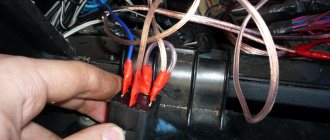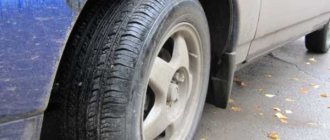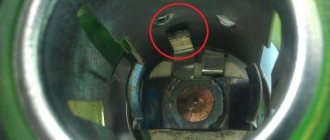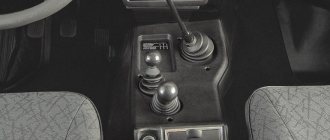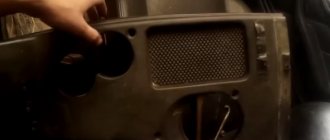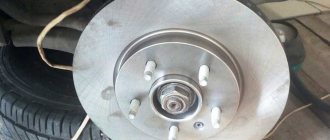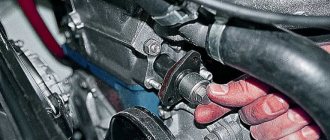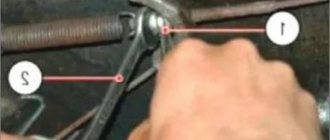- December 10, 2019
- Cars
- Vladimir Skvortsov
The favorite car of fishermen and hunters is the Niva. And the reason for this attitude is the opportunity with its help to get to remote and rarely visited places. What allows you to achieve such results? There is a lock on the Niva. How it helps and in what ways will be discussed below.
About the transmission
First of all, a few words about the structure of the Niva. It has permanent all-wheel drive. What does it mean? It's simple - torque is simultaneously transmitted to four wheels. This is one of the fundamental differences between the Niva and other cars. They supply torque to only one of the axles (front or rear).
All-wheel drive is implemented through the use of a transfer case. The torque, having passed through the gearbox, goes to the transfer case, and from it to the front and rear axles. This design makes it possible to create a locking center differential on the Niva, which, together with all-wheel drive, provides it with increased cross-country ability. Here it is necessary to say a few words about the differential. Largely thanks to him, the excellent off-road characteristics of the Niva are realized.
Understanding the differential
This device allows the car to move freely in a given direction. When turning, the left and right wheels of the car travel different paths. And if they are rigidly connected, then one will slip and the other will slow down. In addition, in this case, the load on the axle increases sharply, which will result in its breakdown or excessive wear of the rubber.
The differential allows you to cope with this problem. On conventional cars it is located on the axle between the wheels, allowing them to rotate independently of each other. The differential distributes the torque received by it between the wheels, and not in equal proportions, but depending on the driving conditions of each - one more, one less.
The same applies to axles in general (front and rear). Their movement, for example when turning, also differs. To distribute forces, a so-called center differential is used. Thanks to it, depending on driving conditions, the torque transmitted to the front and rear axles will differ.
Features of cornering
Here it’s worth mentally (preferably on paper) to draw a schematic picture of how the car turns. This promotes better perception. Just when cornering, the differential starts to come into play. And here the differential lock on the Niva can only do harm. The whole peculiarity is that the wheel, which is closer to the center of the turn (inner), moves along a small radius and covers a shorter distance. And the wheel that is located further from the center of rotation (outer), accordingly moves along a large radius and covers a greater distance.
At the same time, increased resistance acts on the inner wheels of the car, which forces them to reduce their speed. On the contrary, the outer wheels need to move faster, due to the same larger radius. And if there were no differential, each turn would lead to increased wear on the tires of the wheels. And if the speed of the car is high, then a skid cannot be avoided. You should know this before installing a differential lock mechanism on the Chevrolet Niva.
This suggests that the wheels must rotate at different angular speeds. When the car begins to turn, the satellites rotate around their axes, which leads to a slowdown in the speed of the axle shaft of the inner wheel, while the angular speed of the axle shaft of the outer wheel, on the contrary, increases.
This is how the vehicle turns smoothly. Despite the difference in angular speeds, the traction force of all wheels is the same, since the main torque does not change. Of course, this is provided that all wheels have the same grip.
Features of differential operation
The moment is distributed in such a way that it is transferred to where the load is less. This can be confirmed by the usual picture - the car has three wheels on the asphalt, and one on the ice. She fails to move. The friction force of rubber on ice is much less than that of rubber on asphalt, which means that the load on a wheel standing on ice is less than on others.
And the differential transmits all the torque towards the minimum load. As a result, one wheel rotates at breakneck speed, while the rest stand still and the car does not move. The situation is approximately the same when a car cannot climb a mountain on an icy road. In this case, one wheel caught on ice spins, but the car stops.
Work that no one needs is being done. The wheel “grinds” the road surface (ice). Getting rid of such useless work is blocking both on the Niva and on any other car adapted to difficult roads. But usually the devices described are not available on all machines.
Specifications:
- Rated supply voltage - 12V;
- Current consumption - no more than 1.5A;
- Starting current - no more than 5A.
Attention! Driving a vehicle at speeds over 40 km/h, as well as prolonged travel on road surfaces with a high coefficient of adhesion to wheels (dry asphalt, concrete, etc.) with the UltraBLOCK system turned on (locked RPM differential) is PROHIBITED!
Applicability:
Lada 4x4/Niva 3d (VAZ 2121/21214)
Lada 4x4/Niva 5d (VAZ 2131)
This passport, combined with a technical description and operating manual, contains the information necessary for the installation, operation and maintenance of the UltraBLOCK forced electromechanical differential lock of the front axle gearbox.
What are the types of blocking?
Usually there are two types - inter-wheel and inter-axle. The first ones block the operation of the differential installed between the wheels on one axis. The purpose of the interaxle blocking is to ensure the distribution of forces between the axles.
The Niva has three differentials, a center differential and two cross-axle differentials. But they are fundamentally different. If the inter-axle differentials are free, there are no additional devices on them, then the inter-axle differential has a forced lock. It greatly facilitates the movement of the vehicle in off-road conditions, partially giving it the capabilities of an all-terrain vehicle.
Differences between the gearbox and a regular Niva
The car is equipped with a modified version of the classic VAZ 2106 unit with a differential box 21010-2403018-10. It differs from the rear gearbox of the Niva (VAZ 2121) in the gear ratio - 3.9 versus 4.1. This gives the car a higher top speed.
The node also has the following differences:
- a new type of cardan mounting flange;
- reinforced axle gears;
- improved sealing gland.
The last detail deserves special attention.
The oil seal has a protruding rubber boot that rests on a steel dirt-removing disc.
When the axis rotates, dirt and water are thrown away from the contact point due to centrifugal force.
This significantly increases the service life of the unit when used in off-road conditions.
How does the differential lock work on the Niva, the principle of operation
When driving on a normal road, torque is distributed relatively evenly between all wheels. But off-road, in the mud, this is not enough. A simple situation - the car has skidded, for example the left rear wheel. Then all the torque will go there, and the car will not be able to drive. In such a situation, no all-wheel drive will help.
But there is a way out. You need to turn on the center lock. How does such a device work on Niva? The transfer case has a special clutch. When the lock is activated, it connects the shafts that transmit torque to the axles. Let's just say that the force produced by the engine is forcibly divided equally between them. Thus, the entire moment does not go to the slipping wheel, but part of it goes to the front axle (in our example).
Now the four-wheel drive starts working. When the locking is on, the front axle is forced to receive half the torque produced by the engine. Thanks to this, the car starts to move. As soon as it starts moving, the slipping of the rear wheel will stop, and torque will flow to all the others. Then the Niva will safely overcome the difficult section.
It should be noted that the Lada 4x4 car is not the only owner of the described device. A similar differential lock works both on the Chevrolet Niva and on other SUV models, however, it can be implemented in different ways. But nevertheless it performs similar tasks.
My review of Dak and racing
It just so happened that I had to use the two mentioned types of self-blocks. Their price at the time of purchase was almost the same - ten thousand, the installation is also the same, but the result is completely different.
If the DAK failed after about six months, and not in intensive use, but when driving on ordinary forest roads, then the Togliatti one (val racing) is still working.
Maybe I was just unlucky, but I have repeatedly come across reports that there are problems with the quality of the metal in the production of DAKs. So think for yourself.
Is it necessary?
There are a huge number of opinions about whether a self-block is needed at all, and the most polar ones - from “why is it needed” to “is absolutely necessary.” As always, the choice is a personal matter and everyone must make it themselves.
Again, I will only express my opinion.
It seems to me that everything depends on how and where you move in your car. If you go to the country or mostly on asphalt, then you definitely don’t need a self-block.
The situation is approximately the same if your hobby is off-roading and you are engaged in conquering impassable roads. Here, such “half measures” as self-locking will not work and here you need a full manual differential lock.
However, if your task is to overcome not too severe off-road conditions, driving along a wet, broken forest road, i.e. normal conditions without extreme conditions, then self-block can be a good helper in such conditions.
One should also take into account the fact that when using a self-block, additional significant loads arise on the axle shafts and their breakdowns are quite frequent. Therefore, you need to either install reinforced axle shafts, or if there is a very serious obstacle, do not force the car, but arm yourself with a shovel and a jack and help it cope with the trouble.
Maybe it seems to me, maybe I have the self-locking set up this way, maybe that’s not the issue, but often when the car starts to “slip”, a jerk in the opposite direction suddenly appears. It’s as if the car first went to where the wheel was blocked, and then it gained momentum again, and the car jerks in the opposite direction.
Maybe this is not related to the self-blocking system, but I know this feature of the car’s behavior on a broken road and am always ready for it. Perhaps this will be useful to someone. In all respects the behavior of the car is absolutely normal
A self-locking differential for the Niva is a good addition that, if used correctly, can significantly improve its off-road properties.
Read news about the new Niva
- Niva Chevrolet colors catalog
- Review of off-road tires available on the domestic market - 4x4 Club Magazine
- Front bumper “Attack” for VAZ 2123 “Chevrolet Niva” buy inexpensively with delivery to “Ne_vybran”
- Tuning for VAZ Niva 4×4 (LADA Niva) buy with delivery throughout the Russian Federation
- What kind of oil to pour into a Niva Chevrolet box
- Algorithm for starting a carburetor engine @ Niva 4×4
- Technical characteristics of Chevrolet Niva cars (Chevrolet Niva), competitive prices
- LADA Niva Legend 2021: photos, prices, equipment, specifications - New cars 2021-2022, car news on Avtokama.biz
When to use blocking
Under normal road conditions, you don’t need to turn on anything on the Niva. But on a country road or before a steep climb, the driver should think about safety nets. We have already found out how blocking works on Niva. So you should resort to its help if obstacles arise while driving, and this must be done in advance, before the car gets stuck.
If there is a difficult section ahead, it is best to turn on the blocking in advance, especially since it does not take much time. You just need to remember that using the lock unnecessarily does not contribute to the safety of the car and leads to excessive consumption of gasoline and tire wear.
How to enable blocking
It's quite easy to do. On the Lada 4x4 car there are three levers to the right of the driver, we are interested in the smallest one. When the driver moves it back, the lock on the Niva 2121 works; as soon as the driver moves the handle forward, the mode will turn off. It is best to carry out all manipulations while the vehicle is stationary.
Experienced drivers know that the lock does not always turn on (off) the first time. The fact is that the shafts may not be in the right position or they may “bite” if additional force is applied to the coupling (for example, the car has stopped while turning). Then you need to drive forward or backward a little, align the wheels and try again. As a rule, in this case everything turns on.
On the Chevrolet Niva, this procedure is performed differently. There are not two levers to control the transfer case modes, but one. The one we need is located closer to the driver. Although the locks on the Niva-Chevrolet, as well as on the Lada 4x4, work in the same way, they are activated differently. On a Chevrolet, to do this, the transfer case mode control lever must be moved with the clutch depressed while the car is stationary to the left (towards you). To disable the blocking, go in the opposite direction.
Useful tips
To use the lock installed on the Niva effectively, use the following recommendations from experts:
- When driving on good quality road surfaces, install the front transfer handle at the front and the rear at the rear.
- The front handle is moved back if the road becomes slippery. Once the slippery area has been passed, switch the levers to normal mode.
- If the Niva is stopped, the lock may not engage when the clutch is depressed. This occurs due to the alignment of the teeth with the gear teeth. What should you do in this case? Moving as if on a turn, engage the lock. The differential will turn and the gear teeth will come closer to the teeth. If turning off is difficult, do it while the vehicle is moving, maintaining a minimum speed and squeezing the clutch.
The differential lock on the Niva is a faithful assistant to the driver
All-wheel drive does not always provide off-road capability. Often this is not enough. When, as on the Niva, the locking works in conjunction with all-wheel drive, we can say that the car is at least close to all-terrain vehicles. And with such a car it is quite possible, if not to conquer the muddy roads, then to move quite safely along country and abandoned roads.
But do not forget that differential locking is a mode for difficult driving conditions. But there is no need to be afraid of him. We must remember that blocking allows the Niva to drive where others will not even try to do so. But you shouldn’t turn it on unnecessarily in the city. This is fraught with excessive gasoline consumption, tire wear, and ultimately, car breakdown.
Chevrolet Niva expedition › Logbook › * Self-locking differential in the bridge.
Friends, I want to share with you my short report on the operation of a self-locking differential. I would like to warn you right away that this is my personal opinion, which was formed after two years of using such devices.
We will talk about a screw differential lock. In pursuit of the cross-country ability of my former field, I began to build self-blocks into the bridges. After the sale of the Niva, the megadevices migrated to the Shevik, but were later dismantled. The devices are of course very interesting and really help to increase the vehicle's cross-country ability. The truth is not as much as you might expect. Let's just say that self-locking locks help you get stuck further than a standard differential. Sometimes automatic locking even gets in the way, especially on the front axle. This usually happens in slush or snow, when you need to turn onto a slope. The car stubbornly rows along the trajectory that it likes best, which does not always coincide with the driver’s opinion. Another disadvantage of self-blocks, even if only for the rear axle, is that in order for it to work as expected, frequent maintenance is required. In my experience of operating a Chevy in almost civilian mode, about once a quarter it is necessary to remove the lock to tighten the trigger moment. After half a year it doesn't hold up at all. This happens because the device is built on the basis of friction, and what rubs tends to wear off. If you do nothing after the preload weakens, then nothing bad and nothing good happens. The dissolved self-block begins to work like a regular differential, and simply becomes a “pill for the placebo effect.” It is also worth noting that with a fully working self-block, you need to very carefully gas on any heterogeneous surface, including snow and slurry. Especially on large wheels with pronounced tread. It is very easy to collapse the axle shaft in this situation.
To check the operation of a self-locking differential, it is enough to simulate diagonal hanging. Raise the axle under the axle/lever with a jack and try to move out of such a “trap”. If the self-block does not work (requires re-tensioning), then those wheels that are raised in the air will spin, completely simulating the operation of the most ordinary differential. But I did not suggest this to you, and if you follow this method of verification, you rely entirely on your own peril and risk.
For myself, I came to the conclusion that the best blocking is a forced one, which can be turned off; then it interferes or is simply not needed. And the self-locking differential is too “sporty” and requires a lot of attention to maintain. Therefore, after the last weakening of the preload, I decided that this was not suitable for me.
Thank you all for your attention.
